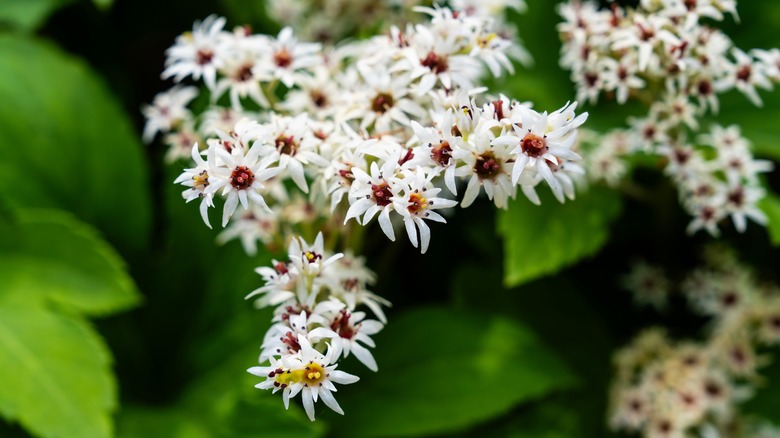Add Color To A Shade Garden With A Flower Pollinators Can't Get Enough Of
Shaded garden beds often leave gardeners scratching their heads, searching for plants that can handle low light while still bringing beauty and life to the space. That's where foamflower (Tiarella cordifolia) steps in. Native to the woodlands of eastern North America, foamflower thrives under the canopy of tall trees, where dappled sunlight and moist, rich soil create the perfect home.
In early to mid-spring, foamflower puts on an eye-catching display. Its slender stalks rise above the dense cover of leaves, carrying clusters of tiny star-shaped blooms that resemble soft, foamy plumes. The buds often carry a hint of pink before opening into creamy white flowers that stay in bloom for four to six weeks. This long bloom time makes foamflower one of the most reliable early-season performers in any shade garden.
Apart from brightening shady corners, foamflower also attracts plenty of visitors. Its nectar-rich flowers bring in pollinators, including bees and butterflies. Even after the flowers fade, the plant keeps looking good. Its heart-shaped leaves, often marked with deep green or burgundy patterns, form a fragrant groundcover that turns bronzy or reddish in the fall. In many climates, the plant cover stays semi-evergreen, keeping the garden looking vibrant and full through much of the year.
How to grow foamflower successfully in your garden
Foamflower may look delicate, but it's surprisingly easy to grow. This shade-loving perennial prefers partial to full shade, thriving in spots that only get a bit of morning sun. Foamflower grows best in soil enriched with humus fertilizer, which helps retain moisture and support healthy root growth. To mimic its natural woodland habitat, mix plenty of compost or organic matter into the soil before planting.
In most regions across the U.S., gardeners grow foamflower successfully in Hardiness Zones 4 through 9. While it can handle cold winters, it performs best when summer heat stays moderate. Keep the soil consistently moist, especially during dry spells, because this plant doesn't tolerate drought. When you plant foamflower, place the crown at the same level as the surrounding soil. Space each one about 12 inches apart so the clumps have room to spread and fill in the area over time.
Foamflower's low-maintenance nature is one of its biggest advantages. It rarely faces serious pest or disease problems, though slugs and snails may occasionally nibble on the leaves. Fortunately, deer and rabbits typically leave it alone thanks to its slightly hairy, unappetizing foliage. Every few years, you can divide crowded clumps in spring or fall to keep plants healthy and encourage even growth. While deadheading spent blooms isn't required, trimming them back can help keep the garden tidy.

